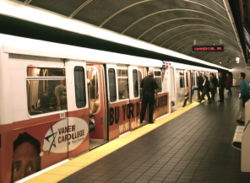 Greater Vancouver leads the Northwest in transit ridership, with somewhere between two and three times as many annual bus and train rides per person as Portland and Seattle.
Greater Vancouver leads the Northwest in transit ridership, with somewhere between two and three times as many annual bus and train rides per person as Portland and Seattle.
So the obvious question: How come? Why does Vancouver do so much better in transit statistics than its southern neighbors?
If you’re from Seattle, the "obvious" answer might seem to be Vancouver’s SkyTrain light rail system, which carries about 66 million passengers each year. Seattle is working hard to expand its measly train system — which currently consists of a lightly used commuter rail service and a 1.6 mile light rail line in Tacoma. But SkyTrain already carries about two-thirds as many passengers as all of King County’s buses.
But SkyTrain can’t be the only explanation for Vancouver’s advantage over its southern neighbors. After all, Portland has MAX light rail, and a streetcar to boot — and Vancouver beats the pants off of Portland, too.
If anything, the MAX system is more robust than SkyTrain: it has more track (71.5 km total, compared with SkyTrain’s 49.5 km) and nearly twice as many stations (64 stations for MAX vs. 33 for SkyTrain). Still, SkyTrain claimed about 66.3 million boardings in 2005, while MAX had fewer than 33 million in 2006 — which means that a typical SkyTrain station handles about four times as many passengers per day, on average, as a typical MAX station.
When you look at bus statistics, Vancouver’s advantage is even more striking. SkyTrain has about twice as many riders as MAX — but Greater Vancouver’s bus system carries about three times as many passengers as greater Portland’s buses. And even though greater Vancouver’s population is about one-third lower than greater Seattle’s, Vancouver-area buses provide one-third more rides than all of Puget Sound’s buses.
(As a sidenote: It turns out that buses are the workhorses of all three cities’ transit systems. Buses carry virtually all of Seattle’s transit passengers, three-quarters of Vancouver’s, and two-thirds of Portland’s.)
What all this statistical mumbo-jumbo means to me is this: when it comes to encouraging transit, mode choice — i.e., train vs. bus vs. streetcar — isn’t the most important factor in determining how many people use a transit system. Not at all.
Far more important is the layout of communities served by transit. In particular, compact neighborhoods can concentrate people and jobs near major transit routes, which helps make transit more convenient and cost-effective. As far as I can tell, Vancouver’s transit advantage stems not from any particular feature of its transit system — the type of trains it uses, or the frequency of bus service — but mostly from its comparatively compact urban form.
To be clear: I am not trying to poo-poo transit expansion plans in Seattle or Portland. And I’m not trying to enter into any sort of bus-vs.-train debate. (Personally, the antipathy between the pro-bus and pro-train camps turns me off, since it seems to dissipate the energies of both sides.) What I am saying is that neither buses nor trains will get as many riders as we might hope — unless we get our neighborhoods right first. That’s where Vancouver’s real transit advantage lies.
 Greater Vancouver leads the Northwest in transit ridership, with somewhere between two and three times as many annual bus and train rides per person as Portland and Seattle.
Greater Vancouver leads the Northwest in transit ridership, with somewhere between two and three times as many annual bus and train rides per person as Portland and Seattle.

